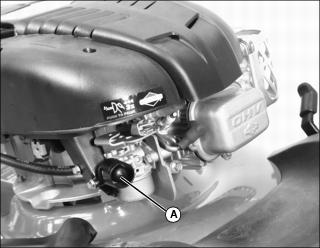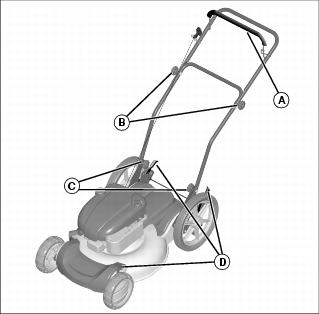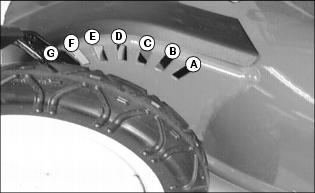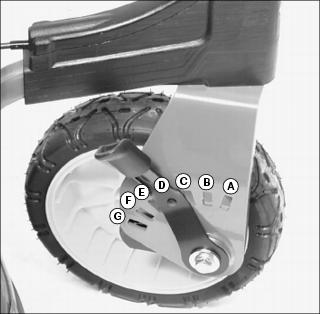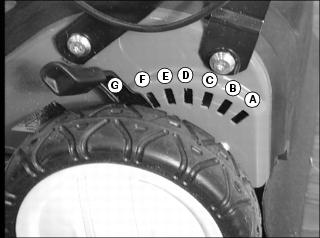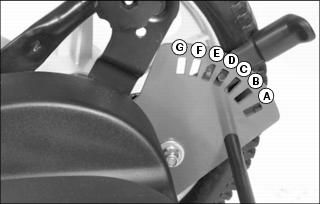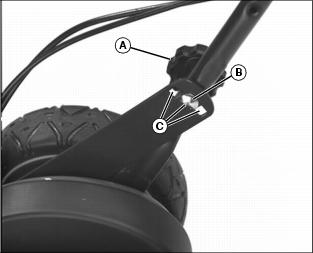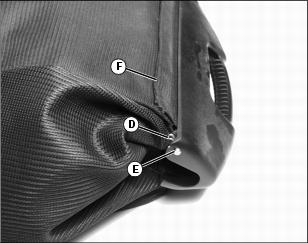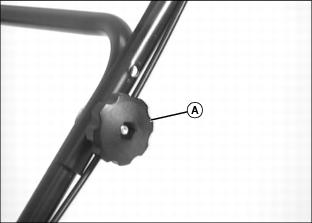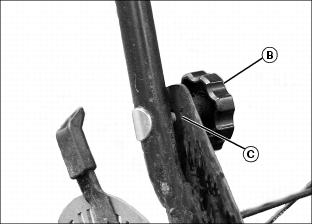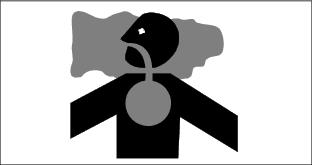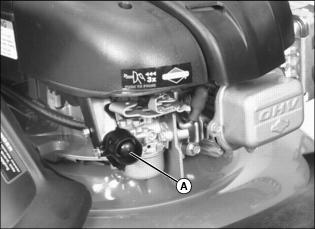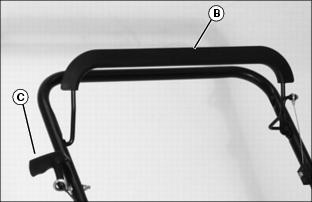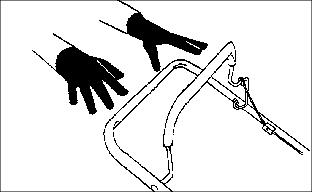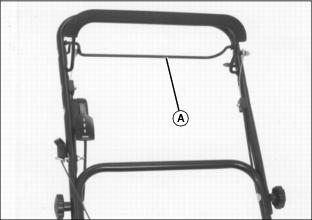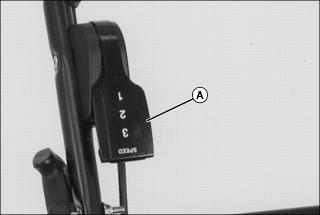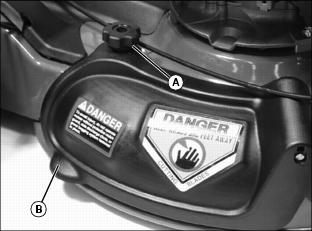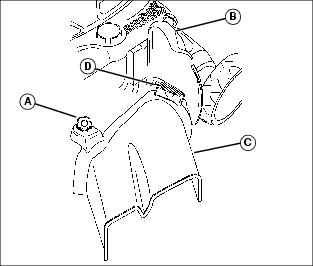
Operating - Mower
Daily Operating Checklist
o Remove grass and debris from machine.
o Check area below machine for leaks.
Avoid Damage to Plastic and Painted Surfaces
· Do not wipe plastic parts unless rinsed first.
· Insect repellent spray may damage plastic and painted surfaces. Do not spray insect repellent near machine.
· Be careful not to spill fuel on machine. Fuel may damage surface. Wipe up spilled fuel immediately.
Primer Bulb
Picture Note: JS61, JS63 and JS63C
Handle Controls
C - Handle Height (Lower) Knobs
Picture Note: JS61, JS63 and JS63C
D - Travel Speed Lever (JS63 and JS63C)
Adjusting Cutting Height
NOTE: Adjust both levers to same height except for two lowest cutting heights (A and B on following chart). At two lowest cutting heights, raise rear lever one notch higher than front lever. This adjustment allows for increased air flow when side discharging, and provides a larger exit window for clippings when mulching.
Begin at upper cutting height, then adjust downward as desired, to avoid scalping lawn with too low a setting.
Picture Note: JS60H Front wheel shown.
Picture Note: JS63C Front wheel shown.
Picture Note: JS63 Left rear wheel shown.
Picture Note: JS60H Right rear wheel shown.
Adjusting front wheel height:
1. Lift lower handlebar slightly with one hand to take some weight off wheel.
2. Move lever to desired position with other hand.
Adjusting rear wheel height:
1. Lift lower handlebar slightly with one hand to take some weight off wheel.
2. Move height adjustment lever to desired position with other hand.
Adjusting Handle Height (JS61, JS63 and JS63C)
Upper Handle:
NOTE: Upper handle height can be independently adjusted to two positions.
1. Remove knob (A) and bolt (B) on each side of handle.
NOTE: If unit is equipped with bagger, bag may prevent lowering of handle.
2. Adjust bagger, if necessary, by removing clip (D) to remove rod (E). Remove rod from lower position (F) and insert in upper position as shown to lengthen bag.
3. Pivot handle to a desired height (C).
4. Install bolt (B) and knob (A) on each side of handle.
Adjusting Handle Height (JS60H)
Upper Handle:
NOTE: Upper handle height can be independently adjusted to two positions.
1. Remove bolt and knob (A) from each side of upper handle.
2. Move handle to desired height.
3. Install bolt through matching holes in upper and lower handles on each side.
4. Install and tighten knob (A).
Lower Handle:
NOTE: Lower handle height can be independently adjusted to three positions.
1. Remove knob (B) and bolt from each side of tractor.
2. Move handle to desired height.
3. Line up square hole in bracket (C) with hole in handle.
4. Install bolt through holes.
Testing Safety Systems
Use the following checkout procedure to check for normal operation of machine.
If there is a malfunction during one of these procedures, do not operate machine. See your John Deere dealer for service.
Perform these tests in a clear open area. Keep bystanders away.
Testing Blade/Engine Control Lever
2. Release blade/engine control lever.
3. Listen for blade and engine to stop. Do not look under mower to check blade.
Result: Blade and engine should stop within three seconds. If blade and engine continue to run, there is a problem with your machine safety system.
Starting Engine
IMPORTANT: Avoid damage! To help prevent damage to starter and band brake, do not start the engine: |
1. Prime engine by pressing primer bulb (A).
2. Move throttle lever to the fast position.
3. Hold blade control lever (B) against handle.
· Engine and blade will stop if blade control lever is released.
4. Pull starter handle (C) until you feel resistance, then pull fast and steady.
5. When engine starts, return rope slowly until handle is in bracket.
Stopping Engine
Forward Travel (JS61, JS63, and JS63C)
To Travel Forward:
Pull and hold traction clutch lever (A) against handle.
To Stop Forward Travel:
Release lever (A). Release lever before you turn.
NOTE: Rear wheels will make a clicking noise when you push mower forward. This means drivetrain is operating correctly.
Travel Speeds
Travel speed (JS61):
· 1st Gear: 3.9 km/h (2.4 mph)
Travel speeds (JS63 and JS63C):
· 1st Gear: 3.1 km/h (1.9 mph)
· 2nd Gear: 3.9 km/h (2.4 mph)
· 3rd Gear: 5.0 km/h (3.1 mph)
To Change Travel Speeds (JS63 and JS63C):
NOTE: Mower travel speed can be changed when the traction clutch lever is engaged and the mower is moving forward.
· Raise or lower speed control lever (A) to engage desired gear.
Using Discharge Chute
1. Release blade control lever to stop engine.
2. Remove mulch guard knob (A) from threaded stud.
3. Lift and hold spring loaded mulch guard (B) up.
4. Install side discharge chute (C) under much guard spring and mounting bracket (D) and lower onto threaded stud.
6. Install and tighten knob (A) onto threaded stud.
Using Mower Blade
Mulch Blade
Mower was delivered from factory with standard mulch blade installed.
Mulch blade works equally well with mulch plug, chute, or bag. There is no need to change blade when you change attachment.
High Lift Blade
See your John Deere dealer to purchase the optional high lift blade.
For best bagging performance use a high lift blade when using the bagger.
Using Grass Bag (Optional)
|
· Bag is subject to wear and deterioration. · Check bag frequently, replace when necessary. · Use John Deere bag or equivalent to comply with safety specifications. |
